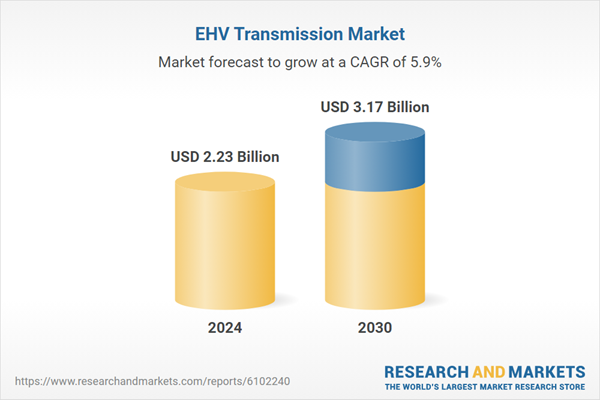Speak directly to the analyst to clarify any post sales queries you may have.
10% Free customizationThis report comes with 10% free customization, enabling you to add data that meets your specific business needs.
Key components include transformers, switchgear, high-capacity lines, insulators, and monitoring systems. The market is expanding rapidly due to rising global energy consumption, the integration of remote renewable energy sources, and grid modernization initiatives. Governments worldwide are prioritizing high-voltage networks to meet the needs of industrial growth, urbanization, and cross-regional energy connectivity. Particularly in regions like Asia-Pacific and Europe, robust EHV systems are essential for ensuring energy reliability, supporting clean energy goals, and enabling intercontinental transmission networks.
Key Market Drivers
Surging Global Electricity Demand
The escalating global demand for electricity is a major growth driver for the EHV Transmission Market, fueled by rapid urbanization, industrial expansion, and adoption of energy-intensive technologies. As countries like China and India develop their industrial infrastructure, the need for high-capacity transmission systems capable of delivering stable power over long distances becomes critical.EHV lines operating above 345 kV help minimize energy losses and support the rising power requirements of data centers, electric vehicles, and smart cities. Additionally, the integration of renewable energy sources located far from consumption centers necessitates long-distance transmission networks. Government investments in infrastructure, coupled with electrification trends across sectors, are pushing utilities to expand and upgrade their transmission capabilities. EHV systems not only meet growing demand but also improve efficiency and grid stability across expansive and diverse geographies.
Key Market Challenges
Financial Barriers Due to Capital-Intensive Nature of EHV Transmission Projects
One of the primary obstacles in the EHV Transmission Market is the significant capital required for developing, installing, and maintaining high-voltage infrastructure. These projects involve substantial costs for advanced components like transformers, high-capacity lines, switchgear, and protection systems, along with land acquisition and compliance with environmental regulations. In emerging economies, funding challenges are exacerbated by limited government budgets and underdeveloped financing frameworks. High up-front investment and long return-on-investment periods make these projects less appealing to private investors. Uncertainties related to regulation, currency fluctuations, inflation, and political factors further raise project risk and financing complexity, delaying implementation even in markets where demand is high.Key Market Trends
Surge in Renewable Energy Integration Driving EHV Transmission Demand
A prominent trend shaping the EHV Transmission Market is the rapid integration of renewable energy sources, necessitating reliable long-distance transmission systems. Large-scale solar and wind energy projects are often situated in remote or offshore areas, requiring EHV networks to deliver power efficiently to urban and industrial zones. EHV infrastructure supports high-capacity, low-loss electricity transfer, making it critical for renewable energy expansion. Governments across Europe, North America, and Asia-Pacific are promoting decarbonization through major investments in green infrastructure, including EHV transmission lines. National and regional policies encouraging low-carbon energy solutions, interconnection projects, and offshore wind development are further reinforcing the need for scalable EHV systems that align with global climate and sustainability targets.Key Market Players
- Siemens Energy AG
- General Electric Company (GE Grid Solutions)
- Hitachi Energy Ltd.
- ABB Ltd.
- Schneider Electric SE
- Mitsubishi Electric Corporation
- Toshiba Energy Systems & Solutions Corporation
- Hyundai Electric & Energy Systems Co., Ltd.
- Nexans S.A.
- Prysmian Group
Report Scope:
In this report, the Global EHV Transmission Market has been segmented into the following categories, in addition to the industry trends which have also been detailed below:EHV Transmission Market, By Voltage Level:
- 220 kV-330 kV
- 331 kV-500 kV
- Above 500 kV
EHV Transmission Market, By Installation Type:
- Overhead Transmission
- Underground Transmission
- Submarine Transmission
EHV Transmission Market, By End-Use Industry:
- Utilities
- Industrial
- Commercial
- Infrastructure
EHV Transmission Market, By Region:
- North America
- United States
- Canada
- Mexico
- Europe
- Germany
- France
- United Kingdom
- Italy
- Spain
- South America
- Brazil
- Argentina
- Colombia
- Asia-Pacific
- China
- India
- Japan
- South Korea
- Australia
- Middle East & Africa
- Saudi Arabia
- UAE
- South Africa
Competitive Landscape
Company Profiles: Detailed analysis of the major companies present in the Global EHV Transmission Market.Available Customizations:
With the given market data, the publisher offers customizations according to a company's specific needs. The following customization options are available for the report.Company Information
- Detailed analysis and profiling of additional market players (up to five).
This product will be delivered within 1-3 business days.
Table of Contents
Companies Mentioned
- Siemens Energy AG
- General Electric Company (GE Grid Solutions)
- Hitachi Energy Ltd.
- ABB Ltd.
- Schneider Electric SE
- Mitsubishi Electric Corporation
- Toshiba Energy Systems & Solutions Corporation
- Hyundai Electric & Energy Systems Co., Ltd.
- Nexans S.A.
- Prysmian Group
Table Information
| Report Attribute | Details |
|---|---|
| No. of Pages | 185 |
| Published | June 2025 |
| Forecast Period | 2024 - 2030 |
| Estimated Market Value ( USD | $ 2.23 Billion |
| Forecasted Market Value ( USD | $ 3.17 Billion |
| Compound Annual Growth Rate | 5.8% |
| Regions Covered | Global |
| No. of Companies Mentioned | 10 |









